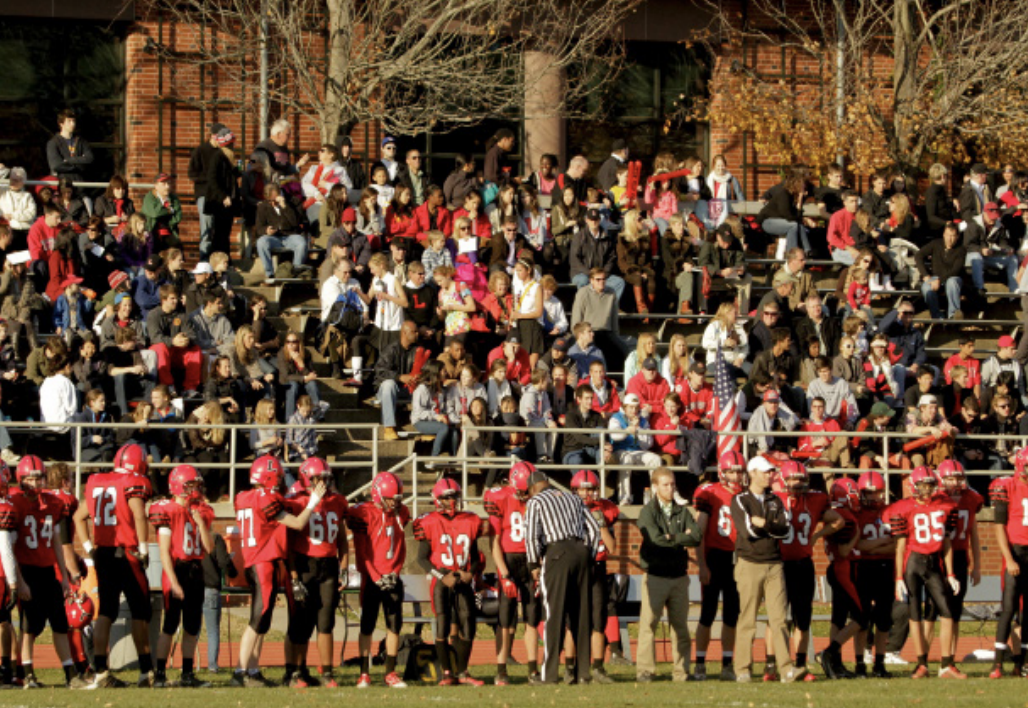Saturday, April 20
Uncovering Traditions of Old and New Hill Day
William Wang ’24 in Features | November 11, 2022

Pepsi and Coca-Cola,; the Los Angeles Lakers and the Boston Celtics,; Ford and Ferrari. None of these rivalries have lasted as long as the one between Lawrenceville and Hill. Dating back to 1887, the Lawrenceville-Hill rivalry is the fifth-oldest high school rivalry in the United States. Although students and faculty hold the same passion for competition today as they did a century and a half ago, it is important to distinguish the current traditions of the rivalry from the competition’s historical roots. While the customs of old have slowly disappeared, it is important to pay tribute and recognize the stories, people, and traditions that allow our rivalry to approach its 136th year.
“In answer to Hill’s cries of ‘Wash that shirt,’ let us in due appreciation of a tradition truly Laurentian [sic], drown out that cry in the stands, as well as on the field.” —Sports Editor David Mackintosh ’44, The Lawrence, October 29, 1943.
Perhaps nothing defines our rivalry with The Hill School more than the phrase, “Wash that shirt,” chanted at football games by Hill, as well as Lawrentians’ reply chant, “We won’t wash that shirt.” The “shirt,” a bright-red football jersey, dates back to the early 1890s, but its origin is disputed. One story claims that it was a token of luck first worn during the Hill Game by Football Captain Garry Cochran, Class of 1893, and had since been passed down through generations of football players, while another states that Walter L. “Turkey” Reiter, Class of 1896, wore the jersey into consultation, defying Lawrenceville’s conservative dress code at the time. Legend has it that Reiter's confidence in Lawrenceville’s victory led him to pledge not to wash said red shirt until Hill had won. This tradition went far beyond the tenure of the captain, lasting until the 1960s. It took 10 years for the shirt to be washed, with Hill finally defeating Lawrenceville in a thrilling 8-0 victory in 1897. Lawrenceville would claim victory in 46 out of their next 65 Hill days—and the shirt would rarely be washed.
In 1973, “95 percent of the School went to Hill with the teams. It’s not like that anymore.”---David Donahue ’73.
Former Head of School Mather Almon Abbott came to embody the true meaning of support and dedication to Lawrenceville. Abbott, who served from 1919-1934, fell ill from pneumonia during the Spring Term of his last year, passing away on May 17, 1934. In the week before his death, Abbott played a strenuous game of tennis, then immediately visited the baseball diamond to improve the spirits of the struggling baseball team that was scheduled to face the strong Hill team the following week. Many believe that he caught a cold as a result of his refusal to wear a jacket on the field. His voice became inaudible during a teachers’ conference on the day of the game against Hill, and although the doctors insisted Abbott go to bed, Abbott opted to depart for our rival school at 10:00 AM instead. He never made it to Hill; he turned back at the Delaware River to preserve his declining health. Known for his endearing dedication to promoting school spirit and supporting his students, Abbott’s tragic story not only reminds us of the impact of his tenure on school history, but of the legacy and importance of cheering on each other during Hill Day.
Similarly to the red shirt, black rhine ties were also a fabled tradition back when jackets and ties were part of the dress code. All new students or “rhinies” were expected to wear black ties to school each day—and if they were caught wearing black and red at the same time, Upperform students would cut their ties off, forcing them to buy a new one.If Lawrenceville’s football team won the Hill game, students would burn their ties; if the team lost, students would be forced wear these ties until the holidays. Other former traditions such as the Woodhull House bonfires and Haka dance, were more recently discontinued. This fiery tradition, however, remains in practice at the Hill School, where after the fabled “Red Meat Dinner,” students huddle around a bonfire in anticipation of game day. Still, many traditions have come and gone. During the early 2000s, faculty members would frequently speak to their rival school’s student bodies. Both schools’ heads have exchanged roles during school meetings, and the recent showing of the “Hill School is My Home” song during school meetings is a contemporary remnant of this tradition.
In a speech he delivered to Lawrentians 2011, the then-Head of the Hill School, David R. Dougherty, remarked, “great rivalries are more like great friendships, committed to the same ideals, and must be nurtured and protected…We must regard this tradition as central to the character, the mission of our schools.” As we move further away from the start of this 136-year-old rivalry, it is important that we preserve the limited number of traditions we have left and to reignite traditions we have left behind. However, we still have time to make new and lasting traditions that embody the spirit of our rivalry.
Related Articles
- Navigating Scheduling Day Helen Chang ’26
- Leading the Boat with the Teeleys Celestine Sutter ’27
- From Passion to Action: Behind the Scenes of LCAPs Mira Ponnambalam ’26
- Senior Profile: Sonia Singhal '24 Mira Ponnambalam ’26
- Learning from the Legacy: Younger Siblings at Lawrenceville Celestine Sutter ’27
Recent Articles
- Concerts, Plays, and All That Jazz: An Update on Spring Productions Jane Shindnes ’26
- How the Need to “Know Ball” Is Destroying Sports Discourse Bryan Boanoh ’25
- Out With the New, In with the Old: What Makes a Gripping Period Piece? Celestine Sutter ’27
- Singing into Spring: A Spring Playlist Riley McKibben ’25
- Earthquake Strikes Campus Mia Kincade ’25